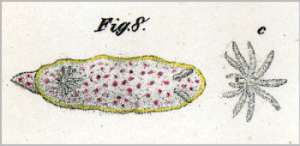
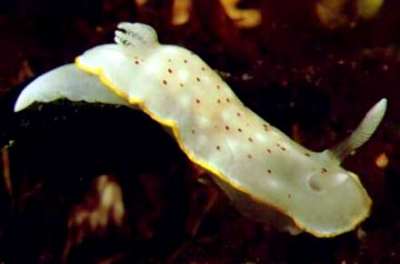
Chromodoris elegantula
(Philippi, 1844)
Order: NUDIBRANCHIA
Suborder: DORIDINA
Superfamily: EUDORIDOIDEA
Family: Chromodorididae
DISTRIBUTION
Mediterranean [France, Italy, Malta, Turkey]
PHOTO
Upper: Original illustration of Doris elegantula Philippi, 1844 [Philippi, 1836: Pl. 19, fig. 8]. Lower: Be_adalar (Five Islands), extreme southwest of Turkey, Mediterranean. Depth: 48 m. Length: 20 mm. 20 May 2005. Coral, algae and sea grass reef. Photographer: Haluk Akbatur.
Animal original described as white with a yellow border to the mantle and red spots scattered over the mantle and on the sides of the body and posterior part of foot. Gills and rhinophores translucent white.
This species has rarely been reported since its original description. Sordi (1970) describes a form in which the red spots are quite large and usually consist of a lighter red patch surrounded by a deep red border. He considers this a distinct subspecies which he names Chromodoris elegantula polychroma. Perrone (1993) reports on specimens of both forms or subspecies from Malta. One distinctive feature in both is that there are diffuse opaque white spots scattered over the mantle.
Little anatomical information on either form. Some information on the radula of C. e. polychroma is given by Sordi (1970) and Perrone (1999) suggesting it is a Chromodoris but I can find no information on the radular morphology of the 'typical' form. A photo of the egg ribbon (Sordi, 1970) of C. e. polychroma shows it has a few large eggs, suggesting it may be a direct developer. It would therefore be valuable to know whether the typical form has a similar type of egg ribbon.
-
Perrone, A. S. (1993) Nudibranchi del genre Chromodoris Alder & Hancock, 1855 dall'Isola di Malta (Opisthobranchia: Nudibranchia). Bollettino Malacologico, 29: 65-80.
-
Philippi, R. A. (1836) Enumeratio molluscorum Sicilae cum viventium tum in tellure tertiaria fossilium quae in itinere sua observavit. [Vol 1]. Berolini, S. Schropp. 1-268. Plates 1-28
-
Philippi, R. A. (1844) Fauna Molluscorum viventium et in tellure tertiaria fossilium regni utriusque Sicilae. [Enumeratio molluscorum Sicilae cum viventium tum in tellure tertiaria fossilium quae in itinere sua observavit. Vol 2.] Halle, E. Anton. 1-304.
-
Pruvot-Fol, A. (1954) Mollusques Opisthobranches. Faune de France, Paris 58: 1-460, Pl.1.
-
Sordi, M. (1970) Nuova ritrovamento di Glossodoris elegantula (Philippi, 1844) (Doris) (Gastropoda, Nudibranchiata). Atti della Unione Malacologica Italiana, 1: 19-29.
Rudman, W.B., 2005 (May 28) Chromodoris elegantula (Philippi, 1844). [In] Sea Slug Forum. Australian Museum, Sydney. Available from http://www.seaslugforum.net/find/chroeleg
Related messages
Re: Chromodoris elegantula
June 3, 2005
From: Juan Lucas Cervera
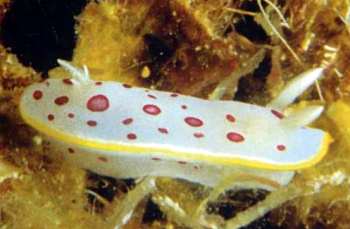
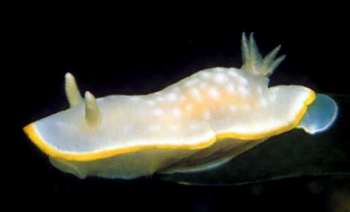
Dear Bill,
Concerning your answer [message #13925]:
My comments were based on Perrone's paper (1993). I had no chance to see Philippi's original description of C. elegantula. Sordi's material (1970) [large-spotted form] attributed to C. elegantula match externally the specimens from Sardinia examined by Garcia-Gomez, Cattaneo and Chemello. Even if the Sordi's radula description is poor, it can be considered "similar" in both material.
I attach scans of two photos published in Trainito (2003):
Upper: [Photo 61 identified in Trainito as C. elegantula] This is similar to those [large-spotted form] studied by Garcia-Gomez et al. [see my earlier message #13925 ]
Lower: [Photo 59 identified in Trainito as Chromodoris sp.] I also attach a photo of the supposed undescribed Chromodoris, I mentioned in my earlier message, quite similar to the small-spotted animal that you attibuted to C. elegantula. It lacks any red spotsand Trainito's photo is from Sicily. The radular teeth of the material examined by Garcia-Gomez et al. were amazing since they were... smooth!!!!!!
For this reason, the material examined by Garcia Gomez et al were considered belonging to 2 different species. But what kind of radular teeth have the animals with the small red spots? This would be very useful. This would permit to know if there are three species or two. In the case of two species, we should accept the existence of a degree of variability with the red punctuation or dots.
I cannot tell you more. I have no material and I'm just 'thinking out loud'.
-
Trainito, E. 2003. Arlecchini mediterranei. Guida ai molluschi opistobranchi del Mediterraneo. [Mediterranean harlequins. A Field Guide to Mediterranean Sea Slugs ] Taphros, Olbia, Italy. 58 pp.
Regards.
Lucas.
lucas.cervera@uca.es
Cervera, J.L., 2005 (Jun 3) Re: Chromodoris elegantula. [Message in] Sea Slug Forum. Australian Museum, Sydney. Available from http://www.seaslugforum.net/find/13934Dear Lucas,
Thanks for your participation. I'm glad someone else is willing to join me 'thinking out loud'. The animal with white spots but no red spots is an interesting addition to the puzzle. As you say, there is not much more we can say about these three 'forms' until we get some more anatomical information. There are either one, two or three species. Whatever transpires, it seems clear to me that the form with small red spots is Doris elegantula Philippi, 1844.
As you will see in a separate message [#13946 ] I have permission from Egidio Trainito to publish your scans of the two photos from his book. He also has some interesting comments on the from without red spots.
Best wishes,
Bill Rudman
Re: Chromodoris elegantula
June 3, 2005
From: Haluk Akbatur
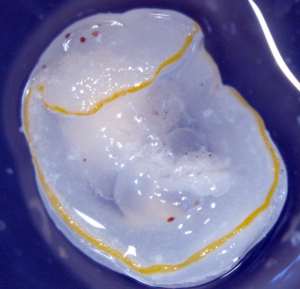
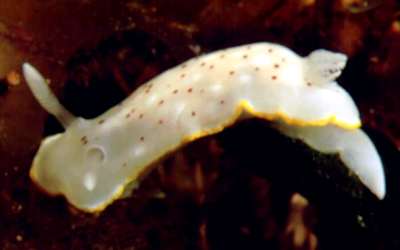
Dear Bill:
In answer to your comments [#13920] I have looked at all the photos I have of Chromodoris elegantula, I should also point out that :
-
There are only few, tiny red spots scattered on posterior part of foot and anterior part of tail.
-
There are diffuse opaque white spots scattered over the mantle between small red spots and nearly ten times bigger than red spots.
-
The gills aren't bipinnate? They looks like unipinnate !?
Regarding these findings can you identify this species?
With my best regards
Haluk
lasergoz@ttnet.net.tr
Akbatur, H.H., 2005 (Jun 3) Re: Chromodoris elegantula. [Message in] Sea Slug Forum. Australian Museum, Sydney. Available from http://www.seaslugforum.net/find/13939Dear Haluk,
Thanks very much for finding the spots, if not many, on the foot. If this species is variable in colouration then it is possible some specimens can have more spots on the body/foot.
Concerning the gills. My mistake - I said 'simple and bipinnate' which is of course a contradiction, I meant to say simple NOT bipinnate. I have changed that sentence to 'The gills are simple [unipinnate],' so there is no confusion.
Can I identify the species? With these old descriptions all we usually have to go on is the original description which we then have to fit to the known fauna. As I see it your animal, with little red spots, is the only species that matches Philippi's description of C. elegantula. Perrone also reports the identical colour 'form' from Malta, which is very close to Sicily, where Philippi first found the species. If the large-spotted form and the un-spotted form mentioned by Lucas Cervera prove the same or different doesn't change the fact that your small-spotted animal fits the original description of Philippi's C. elengantula the best.
As Lucas Cervera implies in his message [#13934] we can't say just how many species there are until we get some more information on their anatomy and biology. Your original query has certainly opened our eyes to an exciting little problem.
Best wishes,
Bill Rudman
Re: Chromodoris elegantula
June 3, 2005
From: Egidio Trainito


Dear Bill,
Of course you can use scans of 59 and 61 pictures from my book. 59 is quite common in the Stagnone di Marsala in Sicily: it is so common that it has been filmed a week ago during the making of a TV series. It was not necessary to search for it, it was only there. It is so common that it would not be difficult to publish it.
Upper: [Photo 59 identified in Trainito as Chromodoris sp.]
Lower: [Photo 61 identified in Trainito as C. elegantula]
-
Trainito, E. 2003. Arlecchini mediterranei. Guida ai molluschi opistobranchi del Mediterraneo. [Mediterranean harlequins. A Field Guide to Mediterranean Sea Slugs ] Taphros, Olbia, Italy. 58 pp.
Thank you for your words about my book. In a few days it will be distributed in a new pocket edition, with more than 180 species and more than 300 photos. I have corrected some mistakes (C. cristallina is actually C. graeca) and identified some previously unknown species (like C. africana ).
Best wishes
Egidio
et@egidiotrainito.it
Trainito, E., 2005 (Jun 3) Re: Chromodoris elegantula. [Message in] Sea Slug Forum. Australian Museum, Sydney. Available from http://www.seaslugforum.net/find/13946Dear Egidio,
Thanks for permission to use your photos and thanks the information on the 'form' without red spots. I hope it doesn't start a 'goldrush' to the Stagnone di Marsala. Did you by chance notice if there were animals with small red spots around as well?
Best wishes,
Bill Rudman
Re: Chromodoris elegantula
June 1, 2005
From: Juan Lucas Cervera
Dear Bill,
This species from Turkey [message #13885] is not Ch. elegantula but an undescribed species of Chromodoris. More than 15 years ago I remember that Jose Carlos Garcia Gomez, Riccardo Cattaneo-Vietti and Renato Chemello had written a manuscript on the genus Chromodoris in Europe, and they included the redescription of Ch. elegantula and an additional undescribed species that matches the Turkish species externally. Unfortunately, this manuscript has never seen the light for different reasons. I remember that the radular teeth of this unnamed species and Ch. elegantula were very different, and those of Ch. elegantula agreed with the Sordi's 1980 redescription.
It would be great to get new material of this undescribed species that permit to conduct the description of this species.
Regards.
Lucas.
lucas.cervera@uca.es
Cervera, J.L., 2005 (Jun 1) Re: Chromodoris elegantula. [Message in] Sea Slug Forum. Australian Museum, Sydney. Available from http://www.seaslugforum.net/find/13925
Dear Lucas,
I have no knowledge of these as living animals but looking at the literature, the animal Sordi (1970) identified as Chromodoris elegantula, with large red patches, doesn't look very like Philippi's illustration which is of a species with many small red spots [see Fact Sheet]. Perrone (1993) reports on specimens he collected in Malta of both the small-spotted 'form' and the large-spotted 'form' and named the large-spotted form as the subspecies Chromodoris elegantula polychroma [see message #13915 ]
Unfortunately we haven't much information on the anatomy of either form. The radula is inadequately described by both Sordi and Perrone. If these two are distinct species then I presume the sensible course would be to follow Perrone and identify the small-spotted form as C. elegantula and the large-spotted form as C. polychroma. The Turkish animals are identical to the small-spotted form of Perrone from Malta. Pruvot-Fol (1954) also illustrates a small-spotted form from Villefranche, France and identifies it as C. elegantula.
Or are you saying there is a third colour 'form' which is the true C. elegantula? If so, then we would have to find out if the small-spotted and large-spotted forms of Perrone are the same species or different. If they are the same, then they both would become C. polychroma and a new name is unnecessary. If you are suggesting that C. elegantula is a third colour 'form' do you know if anyone has a colour photo of it? I have searched the literature and the web and can't find anything else from the Mediterranean which comes near to matching Philippi's illustration.
Best wishes,
Bill Rudman
Re: Chromodoris elegantula
May 31, 2005
From: Haluk Akbatur
Dear Bill,
Concerning your comments [#13885]. Thank you very much for this website, I will took out for Chromodoris elegantula to get some more information on the anatomy and biology of these animals. It has red spots on its foot, do you want more photos ?
Haluk
lasergoz@ttnet.net.tr
Akbatur, H.H. , 2005 (May 31) Re: Chromodoris elegantula. [Message in] Sea Slug Forum. Australian Museum, Sydney. Available from http://www.seaslugforum.net/find/13920Dear Haluk,
I would certainly like any photos you have showing the red spots on the foot and showing variation in the red spots on the mantle. Also if you have any showng the opaque white mantle glands that would be valuable.
Best wishes,
Bill Rudman
Chromodoris elegantula from Turkey
May 30, 2005
From: Haluk Akbatur
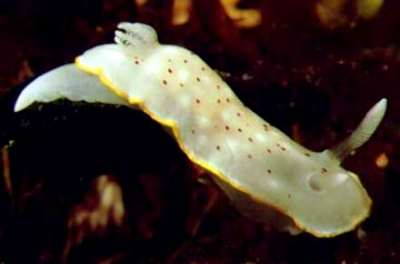
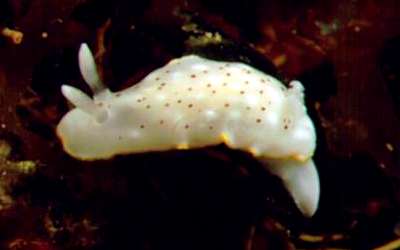
Dear Bill:
I'd like you to help me with the identification of this nudibranch from Be_adalar (Five Islands), which is located in the extreme southwest of Turkey near the Finike.
I think the genus is Chromodoris but I couldn't find the species. At first sight it seems to be Chromodoris daphne, but its rhinophores and gills are uniform translucent white. I found it at about 48 meters on a reef. This is the first time I see this one. I couldn't find any other specimen on the dive.
Locality: Be_adalar (Five Islands), southwestern Turkey. Mediterranean.
Depth: 48 m. Length: 20 mm. 20 May 2005. Coral, algae and sea grass reef. Photographer: Haluk Akbatur.
Thank you for your help.
Haluk Akbatur
lasergoz@tt.net.net.tr
Akbatur, H.H., 2005 (May 30) Chromodoris elegantula from Turkey. [Message in] Sea Slug Forum. Australian Museum, Sydney. Available from http://www.seaslugforum.net/find/13885Dear Haluk,
This is an interesting find. It is Chromodoris elegantula which was described from Sicily in 1844, and since then has only been rediscovered about 3 or 4 times (France, Italy, Malta). I discuss this a bit in the species Fact Sheet. I realise the chances of your seeing it again are not high, but if you, or anyone else, sees it again, it would be nice to know what its egg ribbon looks like. If you have other photos of this animal, could you have a look and see if it has red spots on its foot. I can't see then in the photos you have sent but other descriptions of C. elegantula mention them.
It is another good discovery
Best wishes,
Bill Rudman
Photos of Chromodoris elegantula polychroma
May 30, 2005
From: Alberto Piras
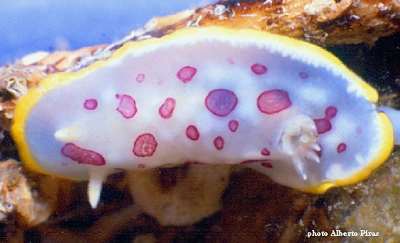
Dear Bill,
To help your report on Chromodoris elegantula, here are some photos of mine of Chromodoris elegantula polychroma Perrone, 1993, from Cagliari, Sardinia, Italy.
Locality: Cagliari, Sardinia, Italy (Divesite: La sella del diavolo). Depth, 3 m. Size: 3 cm. 09 July 1984. Photo: Alberto Piras.
Kind regards,
Alberto Piras
albert.pir@tiscali.it
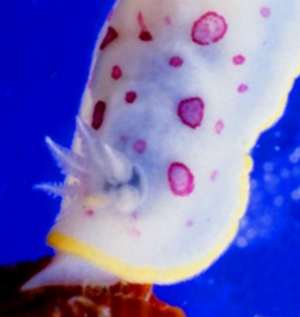
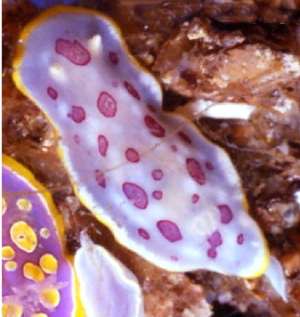
Dear Alberto,
Thanks for your help. Your photos, which I first saw on Erwin Koehler's web site, are a very useful addition to the discussion. Typical Chromodoris elegantula has rarely been reported since its original description. Sordi (1970) considered your colour form, in which the red spots are quite large and usually consist of a lighter red patch surrounded by a deep red border, to be a distinct subspecies which he named Chromodoris elegantula polychroma. Perrone (1993) reports on specimens of both forms or subspecies from Malta. One distinctive feature in both is that there are diffuse opaque white spots scattered over the mantle.
Little anatomical information is available on either form so unless we can get some more information on the anatomy and biology of these animals it won't ne possible to know whether we have one or two species. A photo of the egg ribbon (Sordi, 1970) of C. e. polychroma shows it has a few large eggs, suggesting it may be a direct developer. It would therefore be valuable to know whether the typical form has a similar type of egg ribbon.
Your photos show a couple of anatomical points which are certainly useful. The gills are simple [unipinnate], and the mantle glands consist of a band of ramifying glands at the mantle edge running from about opposite the rhinophores on each side back around the posterior end of the mantle. There is no sign of them around the head end of the mantle. As the arrangement of the mantle glands is often species specific, it would be very interesting to know how these glands are arranged in the typical small spotted 'form'.
-
Perrone, A. S. (1993) Nudibranchi del genre Chromodoris Alder & Hancock, 1855 dall'Isola di Malta (Opisthobranchia: Nudibranchia). Bollettino Malacologico, 29: 65-80.
- Sordi, M. (1970) Nuova ritrovamento di Glossodoris elegantula (Philippi, 1844) (Doris) (Gastropoda, Nudibranchiata). Atti della Unione Malacologica Italiana, 1: 19-29.
Best wishes,
Bill Rudman
